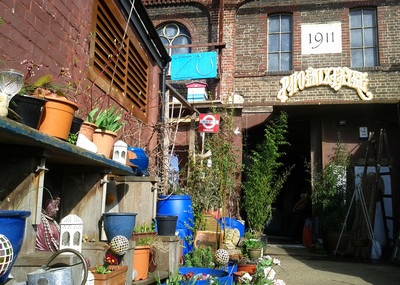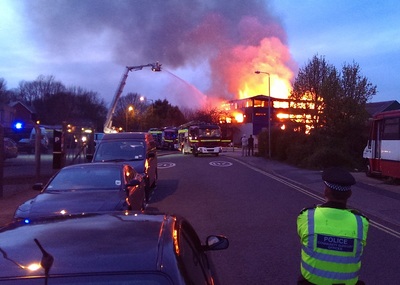In many ways, the destruction of the theatre - from an accident involving a wood-burning stove, it was reported - appeared to catalyse local interest in the site. Back in 2012, many of the buildings had been acquired by the Santon Group and MAS for redevelopment. Their plans were shared as part of a public consultation process that started in 2013. But these plans didn't meet with everyone's approval: Lewes Phoenix Rising was set up in 2014 to propose an alternative scheme that involved renovating some of the Phoenix Ironworks buildings.
Earlier this year came a commission from my friends at Viva Lewes magazine. Would I be interested in writing a series or articles about the various parties involved with what was being called the 'North Street Quarter'? Definitely: it was a story I wanted to learn more about, despite my fear that dealing with rival groups could turn out to be a poisoned chalice. So, on a cold but sunny morning in March, I met Rob Blackman, the leader of Lewes District Council, and Clive Wilding of Santon.
They'd just revealed their proposals, which included 416 new homes, new workspaces, a health centre, additional flood defences for the town and access to the river bank. Rob was there because Lewes District Council owned around 30% of the North Street site, with the Santon/MAS partnership - now a separate company called Santon North Street - responsible for the rest. As I marvelled over the intricate wooden model of the proposed development, I looked for an opportunity to crack a joke about him doing a deal with the devil.
The joke didn't happen. Rob seemed genuinely concerned about trying to do the best thing for the people of Lewes. Both he and Clive gave me considerably more time than they'd scheduled. A cynic might suggest it was in their interest to do so. I think they were genuinely keen to tell their story. Well, either that or my Columbo interviewing technique was unusually effective. "Just one last thing..."
The following month I met Chelsea Renton of Lewes Phoenix Rising over a cup of coffee. Two cups each, by the time we'd finished talking. We were in a small cafe, so I wasn't too surprised when one of the customers joined in to defend Chelsea when she was responding passionately to a particularly provocative question of mine. Afterwards she showed me around one of the former Phoenix buildings, which housed the Foundry Gallery and several manufacturing businesses as well as her own art studio. Yes, that same cynic might suggest it was in her interest to spend time with me. I think it came from a genuine desire to promote the people who worked on the estate.
Just a few days after my meeting with Chelsea, Lewes Town Council (not to be confused with land-owning Lewes District Council) objected to the Santon/LDC planning application. Councillor Susan Murray, who chaired the town council’s planning committee, told me that many of their concerns were about the loss of existing employment and the affordability of housing. She also revealed that nearly all of the planning committee were supporters of Lewes Phoenix Rising. Although the town council's decision wasn't final - that decision was being made by the South Downs National Park Authority - it would need to be considered by the SDNPA.
In May I was busy researching concerns about flooding. Some residents from the Pells area told me that Santon had effectively gone back on a promise. They said Santon's current planning submission showed that Pells-area flood defences wouldn't be completed until phase 3 of the development, despite earlier assurances this would happen during the first phase. After contacting Clive Wilding of Santon North Street, he responded with proposals to amend the planning application and bring forward some of the Pells flood defence work. In the Hollywood blockbuster version of my story, there'd be a headline of 'Local reporter's investigations prompt u-turn'... but I doubt that's what really happened.
And so, eventually, decision day arrived for application SDNP/15/01146/FUL. Thursday 10th December 2015. Because Lewes is part of the South Downs National Park, the final decision needed to be made by the South Downs National Park Authority. Such was the amount of local interest, they came to Lewes for their final meeting instead of holding it in their Midhurst headquarters. Thirteen people would be permitted to speak: some members of the public opposing the application and some supporting the application, as well as town, district and county councillors. Each would have a maximum of three minutes to make their points.
Even before things got started, there was a bit of a clue about the way the meeting would go: the Planning Committee had been given an 82 page document from the Park Authority's Director of Planning, recommending approval of the application subject to a number of terms, which included ensuring that 40% of homes are affordable, getting over a million pounds spent on recreation facilities and spending over £600,000 on creative workspaces. The document had been published on the SDNPA website in the week before the meeting.
A friendly crowd of Phoenix Rising campaigners was greeting people outside as they arrived for the planning meeting. There was singing, there were placards and there were a few dogs (neither holding placards nor singing). Inside, everything ran smoothly. SDNPA case officer Stephen Cantwell presented the application before the discussions started. The only minor hiccups came when Chelsea Renton overran her allotted three-minute speaking time and John Chaplin of Lewes Tree Group insisted he would only address the committee when standing up. No protests, no shouting, just the occasional mutter, tut and sigh from both sides of the debate.
After four hours of presentation, questioning and discussion, the meeting was concluded. Committee chair Neville Harrison quoted Thomas Paine - 'a moderately good thing is not as good as it ought to be' - and Voltaire - 'the best can be the enemy of the good' - before asking the committee to vote on the proposal. It was, he said, "not perfect" but "pretty good". The committee agreed unanimously to approve the plans, although there are many conditions that will need to be confirmed and met before development can start.
Margaret Paren, who chairs the South Downs National Park Authority, said "This is a major application which our planning committee has considered in detail - listening closely to all viewpoints. We recognise that our decision won't be universally welcomed but we believe that it offers the best possible use of this brownfield site for the future of Lewes and the people who live here, including much-needed flood defences and drainage for the whole town and space for recreational facilities."
What next? The whole project will take around six years to finish. For the 'phase 1' part of the site, there'll be demolition in 2016 to make way for the first phase of the development. This is expected to be completed in about two years. Tenancies will end, businesses will need to move, those people who are living on the site will need to find somewhere new. I don't know what the Lewes Phoenix Rising group is going to do, although I imagine its members will be watching closely to ensure all the SDNPA's conditions are met and to see how the £1,145,000 for recreation facilities and the £640,000 for Creative Workspace provision and subsidy is spent.
There's also another potential site nearby that could be redeveloped soon: Waitrose and the derelict Wenban-Smith timber warehouse behind it, plus the bus station. Lewes District Council's proposed joint core strategy talks of this 'Eastgate' site being "a potential area for redevelopment with the priority being for the retention of a major foodstore and introduction of a replacement bus interchange". When I spoke to Clive Wilding in March, he told me a planning application from Waitrose was expected by the end of 2015. That timing now seems unlikely... but it may not be long before Lewes is debating another major development in the town centre.









 RSS Feed
RSS Feed
